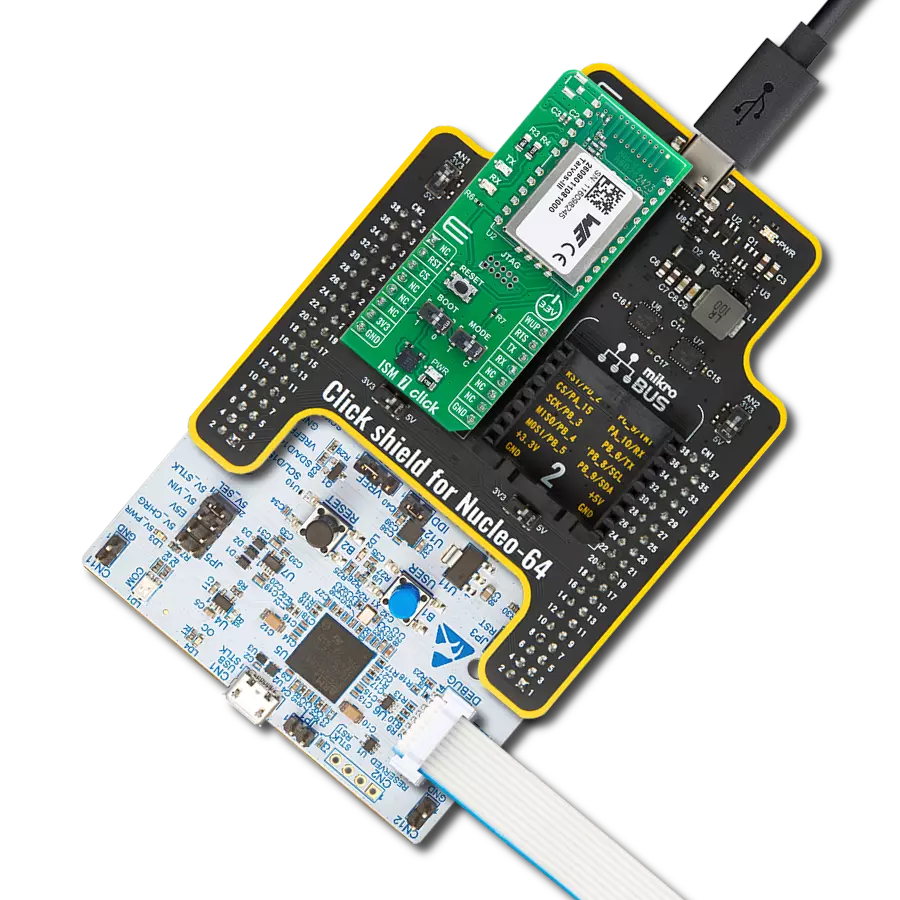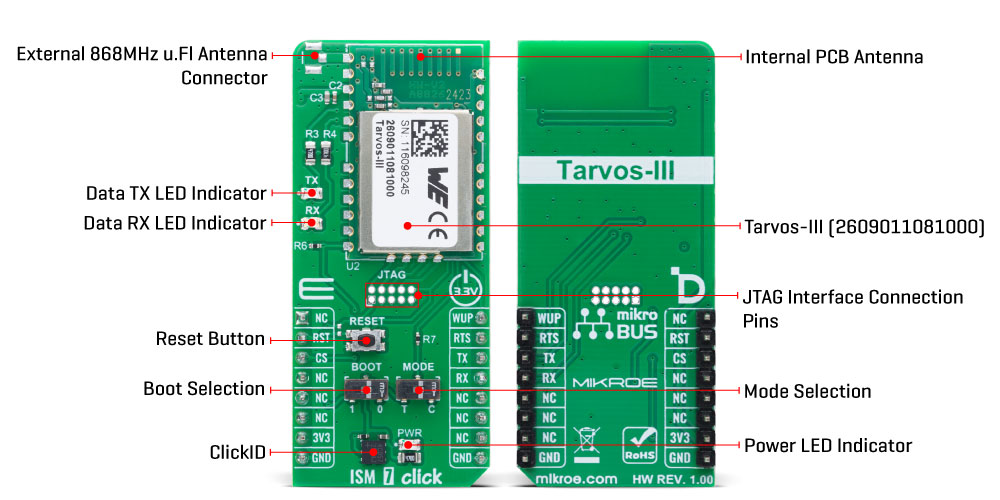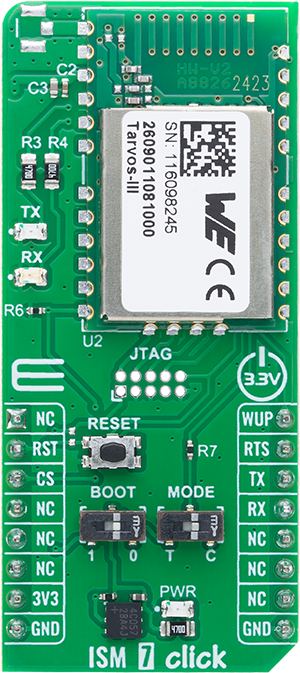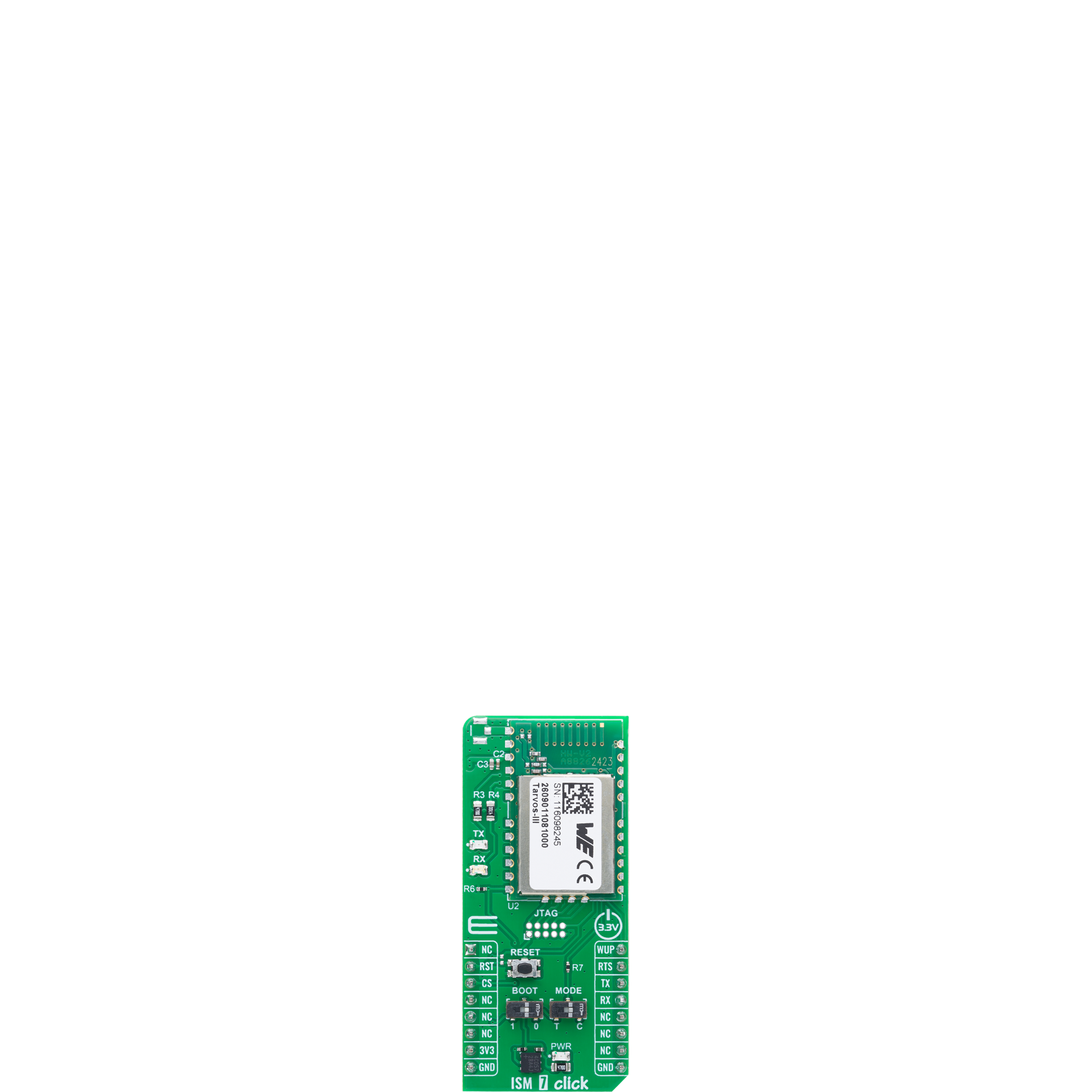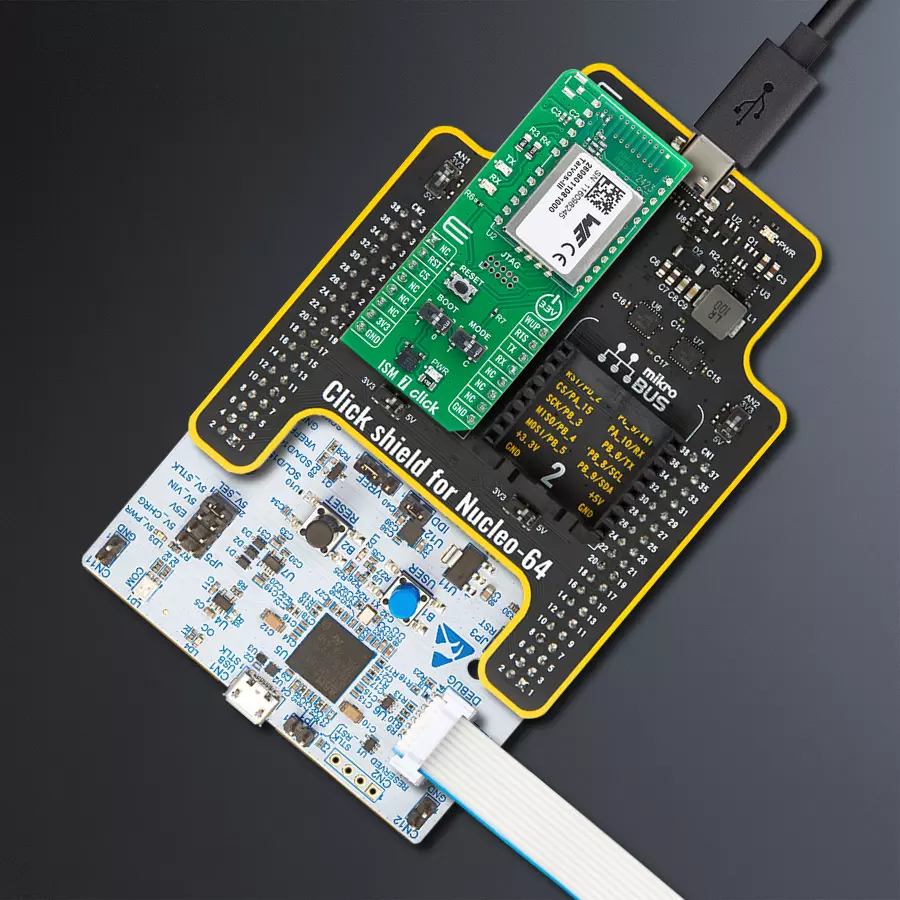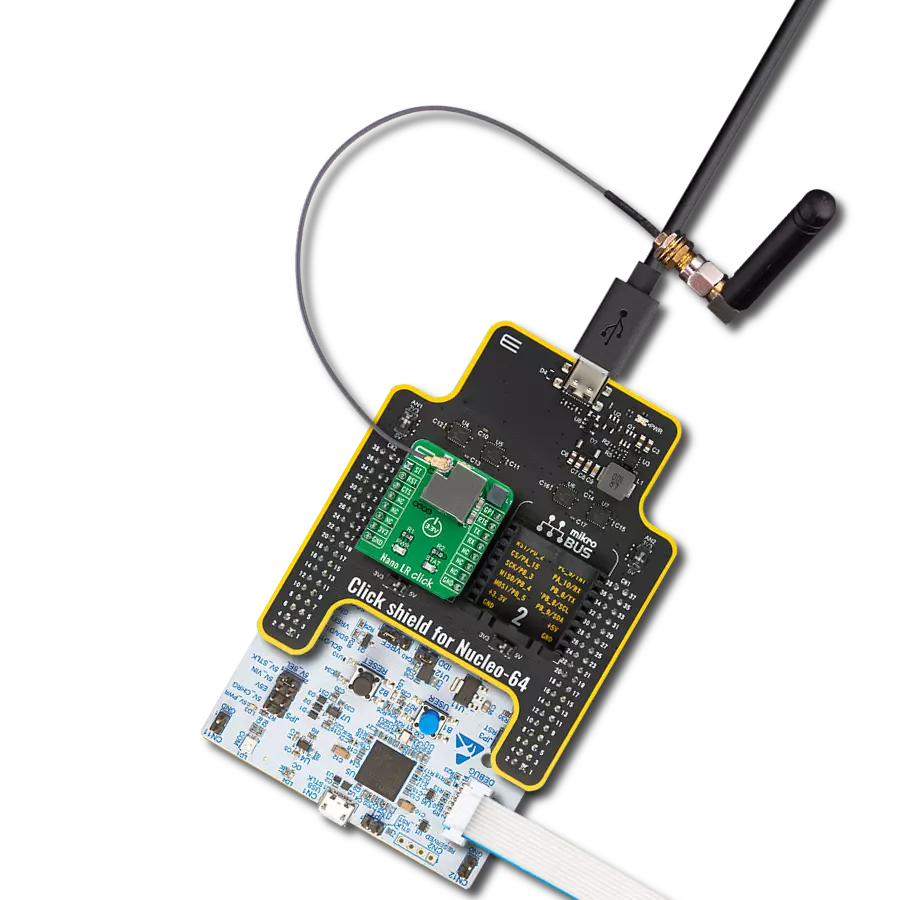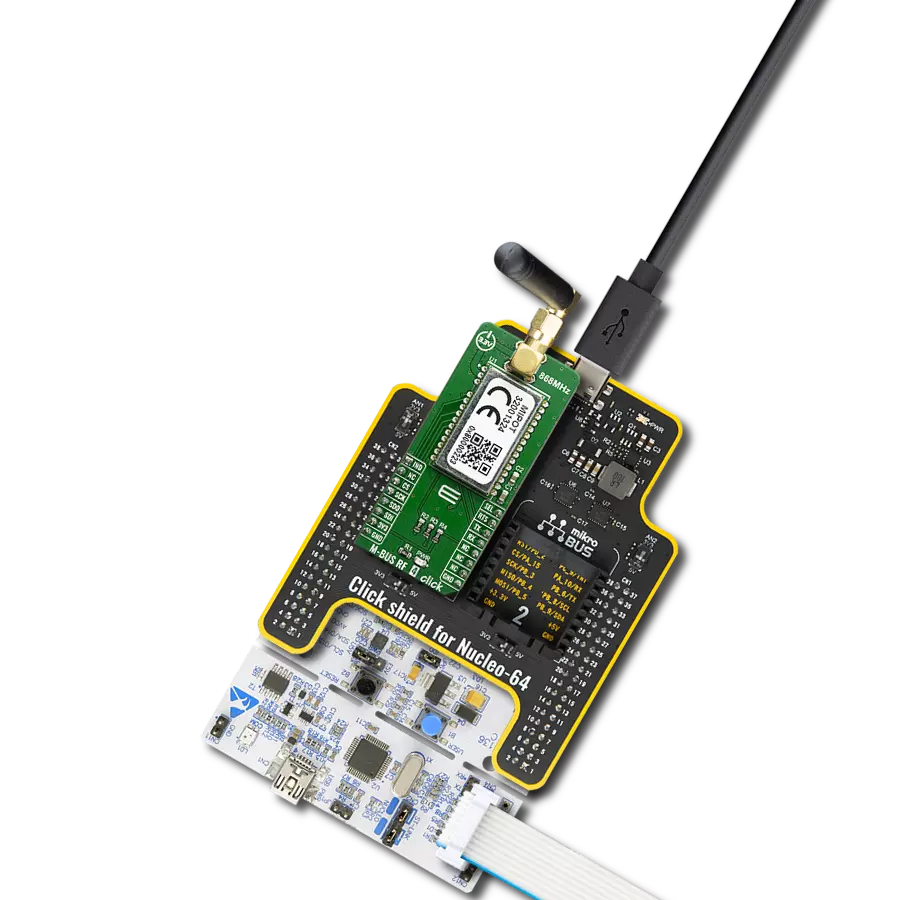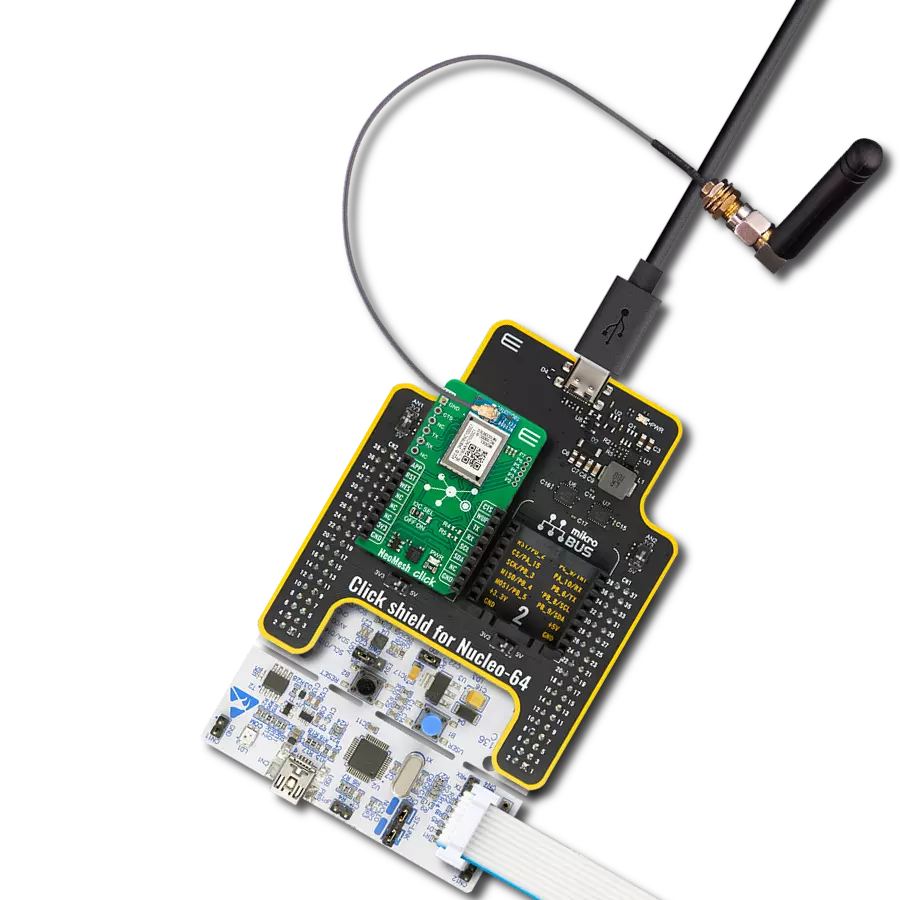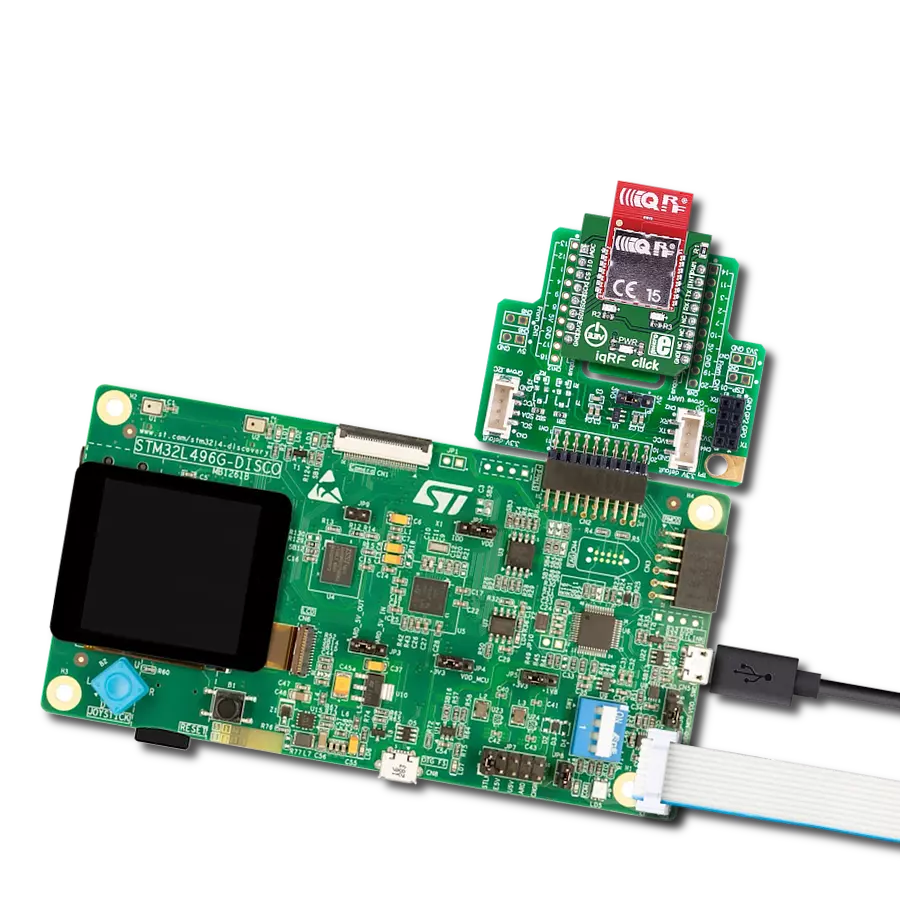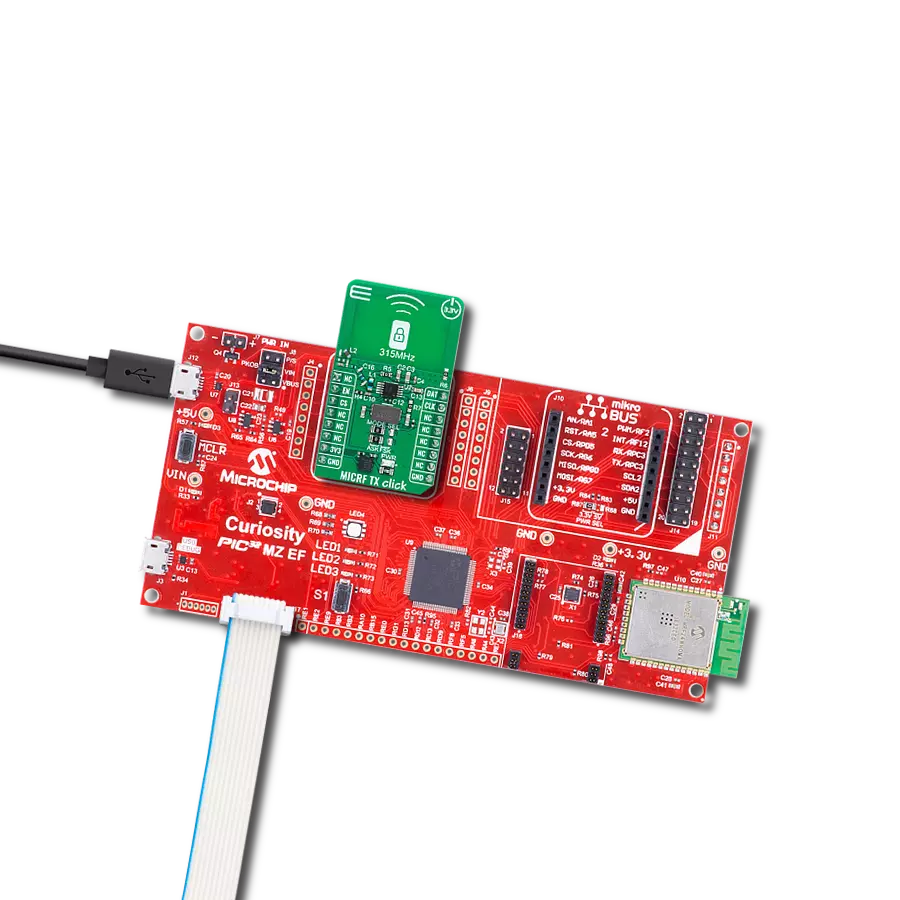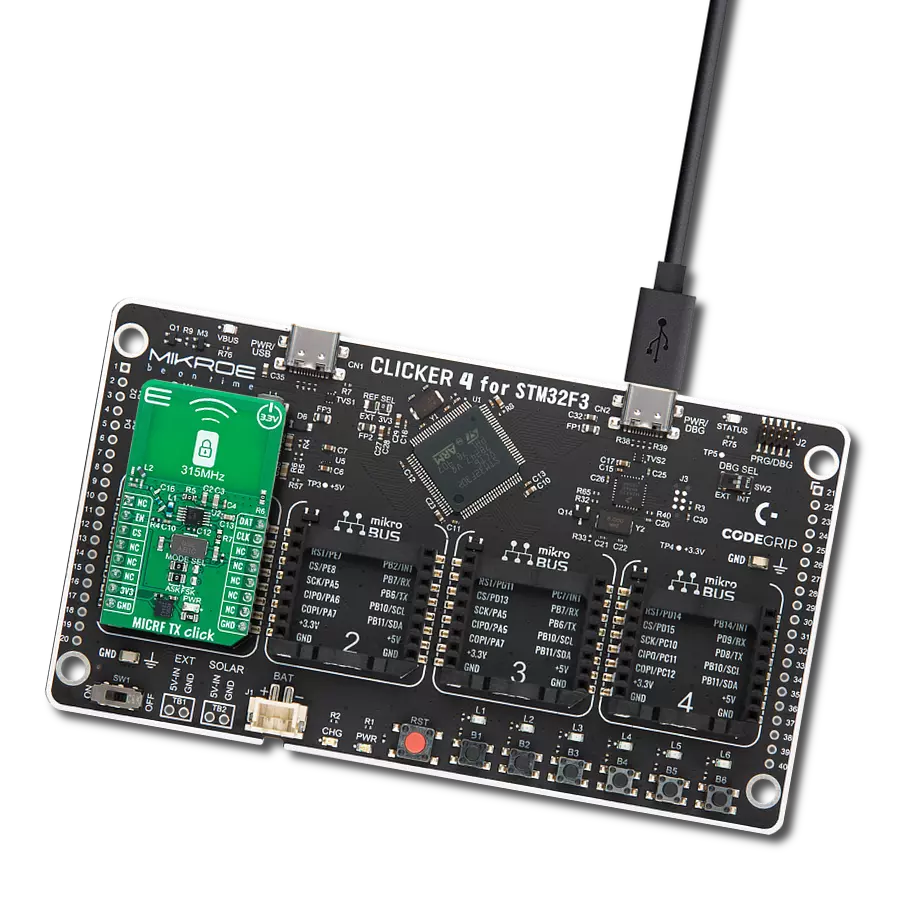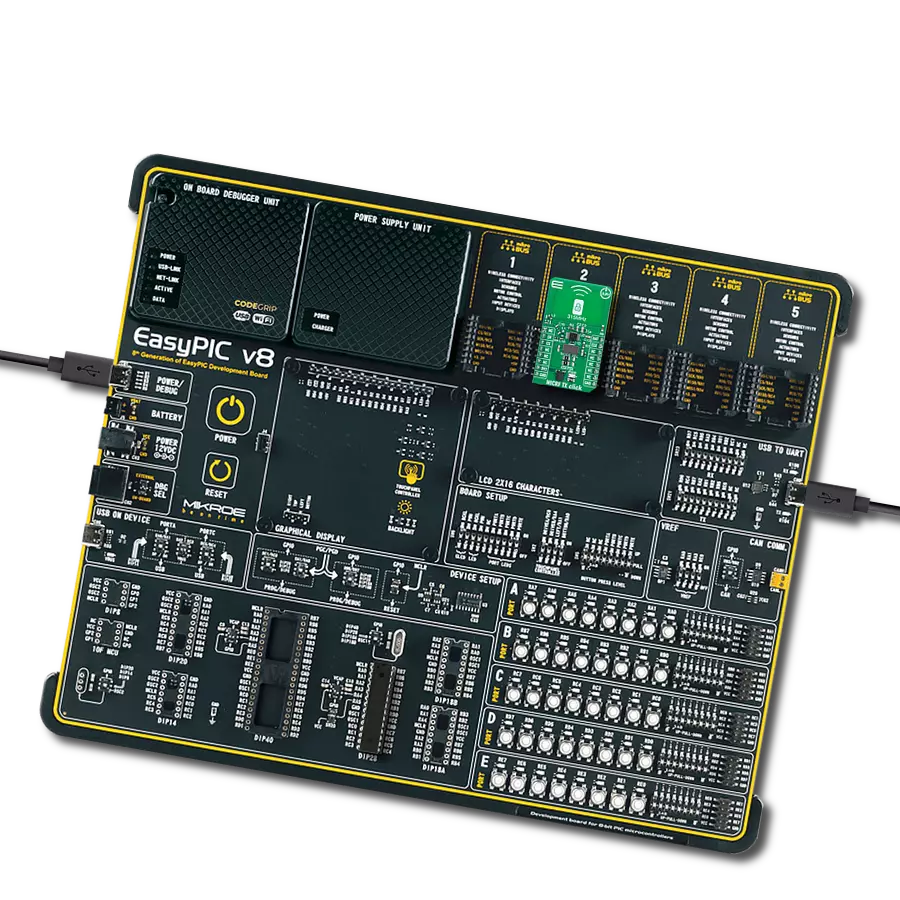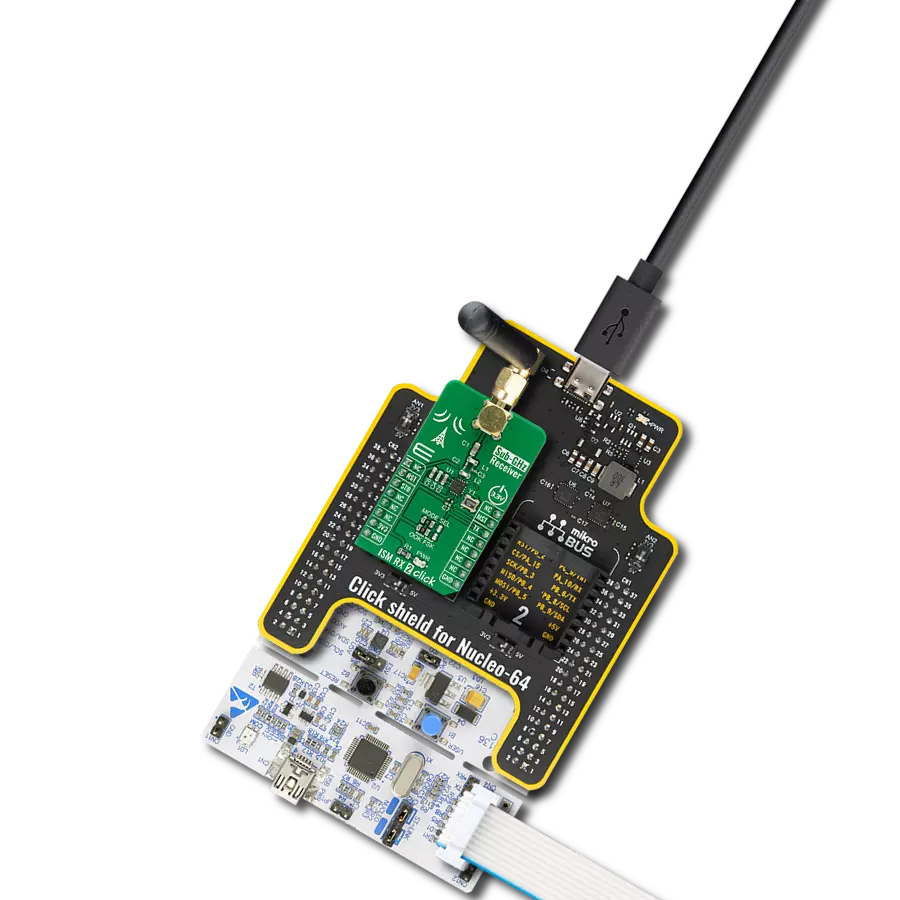Long-range 868MHz wireless connectivity with up to 300m range and Flooding Mesh support
A
A
Hardware Overview
How does it work?
ISM 7 Click is based on the Tarvos-III (2609011081000) radio module from Würth Elektronik, designed for operation within the 868MHz SRD frequency band. This module integrates a high-performance sub-GHz transceiver, the Texas Instruments CC1310, which incorporates a 32-bit ARM Cortex-M3 processor, 128kB of Flash memory, and 20kB of RAM, enabling both communication handling and custom application code execution. The frequency range supported by the module spans from 863MHz to 870MHz, offering reliable connectivity over distances of up to 300 meters in line-of-sight conditions. With a transmission output power of -8dBm and an impressive receiver sensitivity of -104dBm, ISM 7 Click ensures stable wireless communication even in challenging environments. This Click board™ is ideal for a wide range of wireless communication applications such as smart metering, industrial monitoring, building automation, agricultural sensing systems, logistics tracking, and other long-range, low-power IoT applications that operate within the sub-GHz spectrum. The module’s design emphasizes energy efficiency, making it suitable for battery-powered and low-power applications. It features an integrated software stack that supports advanced
networking functionalities, including Flooding Mesh technology, which enables robust multi-hop communication across wide sensor networks. The addressing system is highly flexible, allowing up to 65,535 devices to be organized into 255 independent networks, ideal for scalable IoT deployments. This Click board™ communicates with the host MCU through a UART interface using the standard UART RX and TX pins, and hardware flow control pin (RTS - Ready to Send) for data transfer. The default communication speed is set at 115200bps. It also features two onboard configuration switches - BOOT and MODE - that allow users to easily control the module’s startup behavior. The BOOT switch is used to select the desired boot mode: when set to position 0, the module starts with the pre-loaded application firmware, while setting it to position 1 enables the UART bootloader mode, which is used for performing firmware updates. The MODE switch determines the module’s operational mode during startup. By setting the MODE switch to position 0 during boot, the module enters command mode, allowing the user to send AT-style commands for configuration and control. Alternatively, setting the MODE switch to position 1 during boot places the module into transparent mode, in which all
incoming UART data is transmitted directly over the air. Along with the communication and control pins, this Click board™ also includes a reset pin (RST) and a RESET button, enabling easy module resetting, WUP pin used to wake up the module from shutdown mode, and a set of data LEDs, green TX and red RX, for successful data transmission and reception. The Tarvos-III (2609011081000) module features an onboard antenna for standard operation. However, since the module footprint remains the same, this board can also accommodate alternative Tarvos-III version (2609011181000) that support external antenna. For such cases, the board includes an unsoldered external antenna connector, allowing integration of antennas such as the ISM 868/915MHz Active PCB Antenna. In addition, the board also features pads for JTAG interface signals, an industry-standard solution for verifying designs and testing printed circuit boards. This Click board™ can be operated only with a 3.3V logic voltage level. The board must perform appropriate logic voltage level conversion before using MCUs with different logic levels. It also comes equipped with a library containing functions and example code that can be used as a reference for further development.
Features overview
Development board
Nucleo-64 with STM32G474R MCU offers a cost-effective and adaptable platform for developers to explore new ideas and prototype their designs. This board harnesses the versatility of the STM32 microcontroller, enabling users to select the optimal balance of performance and power consumption for their projects. It accommodates the STM32 microcontroller in the LQFP64 package and includes essential components such as a user LED, which doubles as an ARDUINO® signal, alongside user and reset push-buttons, and a 32.768kHz crystal oscillator for precise timing operations. Designed with expansion and flexibility in mind, the Nucleo-64 board features an ARDUINO® Uno V3 expansion connector and ST morpho extension pin
headers, granting complete access to the STM32's I/Os for comprehensive project integration. Power supply options are adaptable, supporting ST-LINK USB VBUS or external power sources, ensuring adaptability in various development environments. The board also has an on-board ST-LINK debugger/programmer with USB re-enumeration capability, simplifying the programming and debugging process. Moreover, the board is designed to simplify advanced development with its external SMPS for efficient Vcore logic supply, support for USB Device full speed or USB SNK/UFP full speed, and built-in cryptographic features, enhancing both the power efficiency and security of projects. Additional connectivity is
provided through dedicated connectors for external SMPS experimentation, a USB connector for the ST-LINK, and a MIPI® debug connector, expanding the possibilities for hardware interfacing and experimentation. Developers will find extensive support through comprehensive free software libraries and examples, courtesy of the STM32Cube MCU Package. This, combined with compatibility with a wide array of Integrated Development Environments (IDEs), including IAR Embedded Workbench®, MDK-ARM, and STM32CubeIDE, ensures a smooth and efficient development experience, allowing users to fully leverage the capabilities of the Nucleo-64 board in their projects.
Microcontroller Overview
MCU Card / MCU
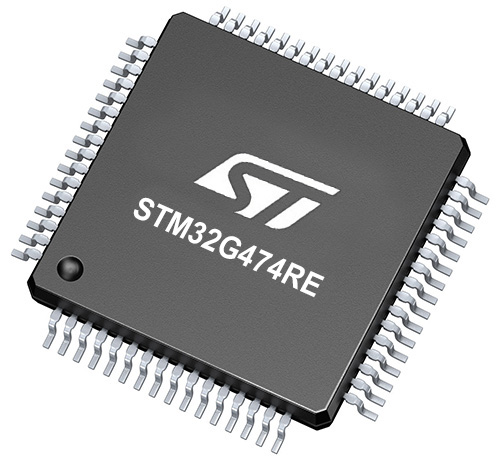
Architecture
ARM Cortex-M4
MCU Memory (KB)
512
Silicon Vendor
STMicroelectronics
Pin count
64
RAM (Bytes)
128k
You complete me!
Accessories
Click Shield for Nucleo-64 comes equipped with two proprietary mikroBUS™ sockets, allowing all the Click board™ devices to be interfaced with the STM32 Nucleo-64 board with no effort. This way, Mikroe allows its users to add any functionality from our ever-growing range of Click boards™, such as WiFi, GSM, GPS, Bluetooth, ZigBee, environmental sensors, LEDs, speech recognition, motor control, movement sensors, and many more. More than 1537 Click boards™, which can be stacked and integrated, are at your disposal. The STM32 Nucleo-64 boards are based on the microcontrollers in 64-pin packages, a 32-bit MCU with an ARM Cortex M4 processor operating at 84MHz, 512Kb Flash, and 96KB SRAM, divided into two regions where the top section represents the ST-Link/V2 debugger and programmer while the bottom section of the board is an actual development board. These boards are controlled and powered conveniently through a USB connection to program and efficiently debug the Nucleo-64 board out of the box, with an additional USB cable connected to the USB mini port on the board. Most of the STM32 microcontroller pins are brought to the IO pins on the left and right edge of the board, which are then connected to two existing mikroBUS™ sockets. This Click Shield also has several switches that perform functions such as selecting the logic levels of analog signals on mikroBUS™ sockets and selecting logic voltage levels of the mikroBUS™ sockets themselves. Besides, the user is offered the possibility of using any Click board™ with the help of existing bidirectional level-shifting voltage translators, regardless of whether the Click board™ operates at a 3.3V or 5V logic voltage level. Once you connect the STM32 Nucleo-64 board with our Click Shield for Nucleo-64, you can access hundreds of Click boards™, working with 3.3V or 5V logic voltage levels.
Used MCU Pins
mikroBUS™ mapper
Take a closer look
Click board™ Schematic
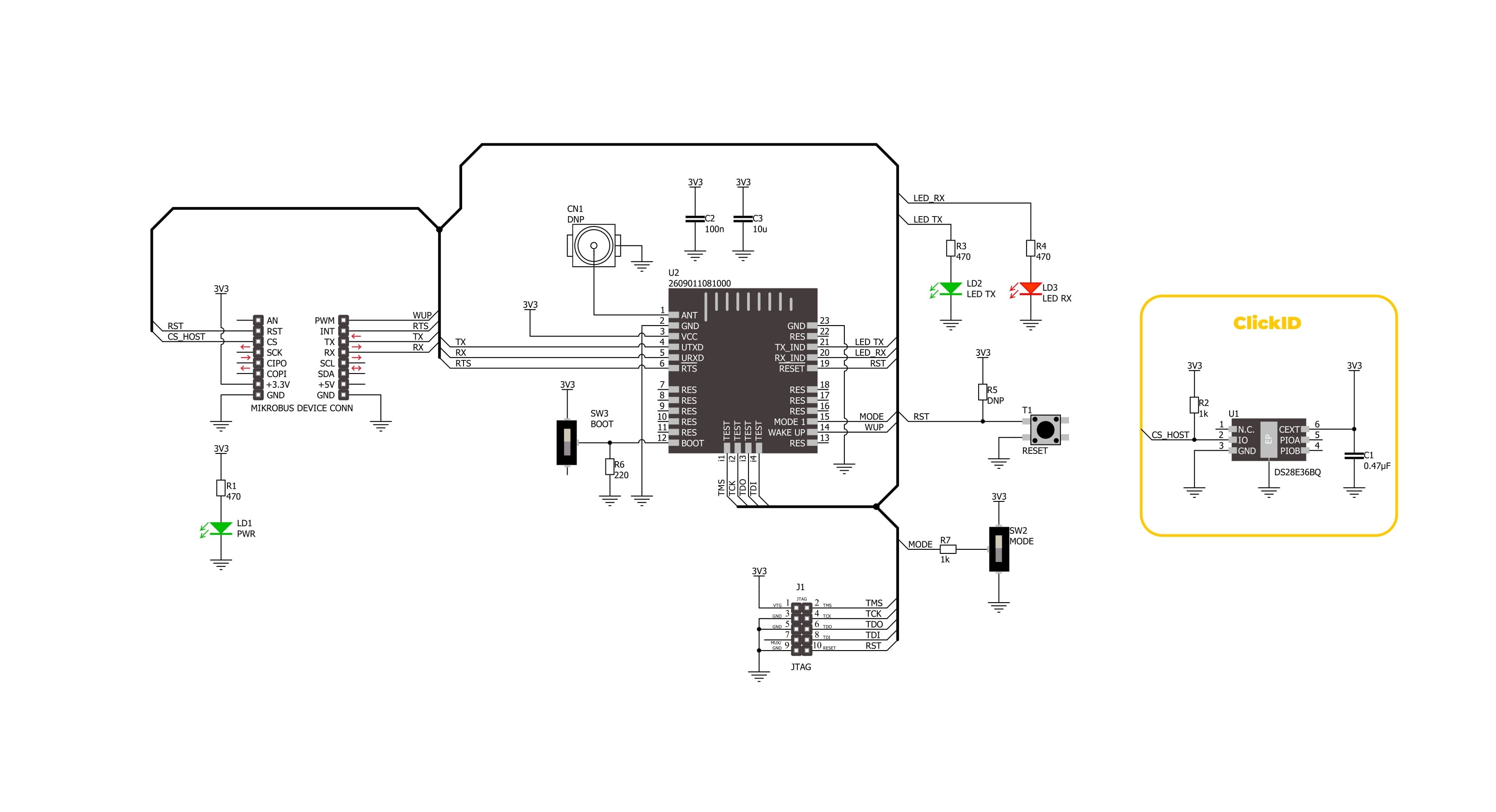
Step by step
Project assembly
Track your results in real time
Application Output
1. Application Output - In Debug mode, the 'Application Output' window enables real-time data monitoring, offering direct insight into execution results. Ensure proper data display by configuring the environment correctly using the provided tutorial.

2. UART Terminal - Use the UART Terminal to monitor data transmission via a USB to UART converter, allowing direct communication between the Click board™ and your development system. Configure the baud rate and other serial settings according to your project's requirements to ensure proper functionality. For step-by-step setup instructions, refer to the provided tutorial.

3. Plot Output - The Plot feature offers a powerful way to visualize real-time sensor data, enabling trend analysis, debugging, and comparison of multiple data points. To set it up correctly, follow the provided tutorial, which includes a step-by-step example of using the Plot feature to display Click board™ readings. To use the Plot feature in your code, use the function: plot(*insert_graph_name*, variable_name);. This is a general format, and it is up to the user to replace 'insert_graph_name' with the actual graph name and 'variable_name' with the parameter to be displayed.

Software Support
Library Description
ISM 7 Click demo application is developed using the NECTO Studio, ensuring compatibility with mikroSDK's open-source libraries and tools. Designed for plug-and-play implementation and testing, the demo is fully compatible with all development, starter, and mikromedia boards featuring a mikroBUS™ socket.
Example Description
This example demonstrates the use of ISM 7 Click board by showing the communication between two Click boards.
Key functions:
ism7_cfg_setup- This function initializes Click configuration structure to initial values.ism7_init- This function initializes all necessary pins and peripherals used for this Click board.ism7_send_cmd- This function sends a desired command packet from the Click context object.ism7_read_event- This function reads an event packet from the ring buffer and stores it in the Click context object.ism7_get_user_setting- This function reads data from the desired user settings index and stores it in the Click context event packet object.
Application Init
Initializes the driver, resets the Click board, reads the device info, and sends a message to initiate the communication with other Click board.
Application Task
Reads and parses all the received event packets and displays them the USB UART. All incoming data messages received from the connected device will be echoed back.
Open Source
Code example
The complete application code and a ready-to-use project are available through the NECTO Studio Package Manager for direct installation in the NECTO Studio. The application code can also be found on the MIKROE GitHub account.
/*!
* @file main.c
* @brief ISM 7 Click Example.
*
* # Description
* This example demonstrates the use of ISM 7 Click board by showing
* the communication between two Click boards.
*
* The demo application is composed of two sections :
*
* ## Application Init
* Initializes the driver, resets the Click board, reads the device info, and sends
* a message to initiate the communication with other Click board.
*
* ## Application Task
* Reads and parses all the received event packets and displays them the USB UART.
* All incoming data messages received from the connected device will be echoed back.
*
* ## Additional Function
* - static err_t ism7_parse_cnf ( ism7_t *ctx )
* - static err_t ism7_parse_ind ( ism7_t *ctx )
* - static err_t ism7_parse_event ( ism7_t *ctx )
*
* @author Stefan Filipovic
*
*/
#include "board.h"
#include "log.h"
#include "ism7.h"
// Text message to send to initiate communication
#define DEMO_TEXT_MESSAGE "MIKROE - ISM 7 Click board"
static ism7_t ism7;
static log_t logger;
/**
* @brief ISM 7 parse cnf function.
* @details This function parses all received confirmation packets and displays them on the USB UART.
* @param[in] ctx : Click context object.
* See #ism7_t object definition for detailed explanation.
* @return @li @c 0 - Packet parsed successfully,
* @li @c 1 - Error.
* See #err_t definition for detailed explanation.
* @note None.
*/
static err_t ism7_parse_cnf ( ism7_t *ctx );
/**
* @brief ISM 7 parse ind function.
* @details This function parses all received indication packets and displays them on the USB UART.
* @param[in] ctx : Click context object.
* See #ism7_t object definition for detailed explanation.
* @return @li @c 0 - Packet parsed successfully,
* @li @c 1 - Error.
* See #err_t definition for detailed explanation.
* @note None.
*/
static err_t ism7_parse_ind ( ism7_t *ctx );
/**
* @brief ISM 7 parse event function.
* @details This function parses all received packets and displays them on the USB UART.
* @param[in] ctx : Click context object.
* See #ism7_t object definition for detailed explanation.
* @return @li @c 0 - Packet parsed successfully,
* @li @c 1 - Error.
* See #err_t definition for detailed explanation.
* @note None.
*/
static err_t ism7_parse_event ( ism7_t *ctx );
void application_init ( void )
{
log_cfg_t log_cfg; /**< Logger config object. */
ism7_cfg_t ism7_cfg; /**< Click config object. */
/**
* Logger initialization.
* Default baud rate: 115200
* Default log level: LOG_LEVEL_DEBUG
* @note If USB_UART_RX and USB_UART_TX
* are defined as HAL_PIN_NC, you will
* need to define them manually for log to work.
* See @b LOG_MAP_USB_UART macro definition for detailed explanation.
*/
LOG_MAP_USB_UART( log_cfg );
log_init( &logger, &log_cfg );
log_info( &logger, " Application Init " );
// Click initialization.
ism7_cfg_setup( &ism7_cfg );
ISM7_MAP_MIKROBUS( ism7_cfg, MIKROBUS_1 );
if ( UART_ERROR == ism7_init( &ism7, &ism7_cfg ) )
{
log_error( &logger, " Communication init." );
for ( ; ; );
}
log_printf( &logger, ">> Reset device.\r\n" );
if ( ISM7_ERROR == ism7_reset_device ( &ism7 ) )
{
log_error( &logger, " Reset device." );
for ( ; ; );
}
log_printf( &logger, ">> Get device info.\r\n" );
if ( ISM7_OK == ism7_get_user_setting ( &ism7, ISM7_SET_IDX_FACTORY_SETTINGS ) )
{
log_printf( &logger, " < Serial number: 0x%.2X%.2X%.2X%.2X\r\n",
( uint16_t ) ism7.evt_pkt.payload[ 4 ],
( uint16_t ) ism7.evt_pkt.payload[ 3 ],
( uint16_t ) ism7.evt_pkt.payload[ 2 ],
( uint16_t ) ism7.evt_pkt.payload[ 1 ] );
log_printf( &logger, " Hardware version: %u.%u.%u\r\n",
( uint16_t ) ism7.evt_pkt.payload[ 5 ],
( uint16_t ) ism7.evt_pkt.payload[ 6 ],
( uint16_t ) ism7.evt_pkt.payload[ 7 ] );
log_printf( &logger, " Frequency correction factor: %u\r\n",
( uint16_t ) ism7.evt_pkt.payload[ 8 ] );
}
log_printf( &logger, ">> Get FW version.\r\n" );
if ( ISM7_OK == ism7_get_user_setting ( &ism7, ISM7_SET_IDX_FIRMWARE_VERSION ) )
{
log_printf( &logger, " < FW version: %u.%u.%u\r\n\n",
( uint16_t ) ism7.evt_pkt.payload[ 3 ],
( uint16_t ) ism7.evt_pkt.payload[ 2 ],
( uint16_t ) ism7.evt_pkt.payload[ 1 ] );
}
log_printf( &logger, ">> Send message to initiate communication.\r\n" );
ism7.cmd_pkt.cmd = ISM7_CMD_REQ_DATA;
ism7.cmd_pkt.payload_len = strlen ( DEMO_TEXT_MESSAGE );
strcpy ( ism7.cmd_pkt.payload, DEMO_TEXT_MESSAGE );
if ( ISM7_OK == ism7_send_cmd ( &ism7 ) )
{
if ( ISM7_OK == ism7_wait_for_event ( &ism7, ISM7_CMD_CNF_DATA, ISM7_WAIT_TIME_1S ) )
{
ism7_parse_event ( &ism7 );
}
}
log_info( &logger, " Application Task " );
}
void application_task ( void )
{
if ( ISM7_OK == ism7_read_event ( &ism7 ) )
{
ism7_parse_event ( &ism7 );
}
}
int main ( void )
{
/* Do not remove this line or clock might not be set correctly. */
#ifdef PREINIT_SUPPORTED
preinit();
#endif
application_init( );
for ( ; ; )
{
application_task( );
}
return 0;
}
static err_t ism7_parse_cnf ( ism7_t *ctx )
{
err_t error_flag = ISM7_OK;
uint16_t byte_cnt = 0;
if ( ISM7_CMD_TYPE_CNF == ( ctx->evt_pkt.cmd & ISM7_CMD_TYPE_MASK ) )
{
// Parse confirmation packet
switch ( ctx->evt_pkt.cmd )
{
case ISM7_CMD_CNF_GET:
{
log_printf( &logger, " < GET_CNF -> " );
switch ( ctx->evt_pkt.payload[ 0 ] )
{
case ISM7_CNF_GET_STATUS_OK:
{
log_printf( &logger, "Request successfully received and processed" );
break;
}
case ISM7_CNF_GET_STATUS_FAILED:
{
log_printf( &logger, "Request not successful" );
break;
}
default:
{
log_printf( &logger, "Unknown status: 0x%.2X", ( uint16_t ) ctx->evt_pkt.payload[ 0 ] );
break;
}
}
if ( ctx->evt_pkt.payload_len > 1 )
{
log_printf( &logger, "\r\n Setting: " );
for ( byte_cnt = 1; byte_cnt < ctx->evt_pkt.payload_len; byte_cnt++ )
{
log_printf( &logger, "0x%.2X ", ( uint16_t ) ctx->evt_pkt.payload[ byte_cnt ] );
}
}
break;
}
case ISM7_CMD_CNF_DATA:
{
log_printf( &logger, " < DATA_CNF -> " );
switch ( ctx->evt_pkt.payload[ 0 ] )
{
case ISM7_CNF_DATA_STATUS_ACK:
{
log_printf( &logger, "ACK received or not requested" );
break;
}
case ISM7_CNF_DATA_STATUS_NACK:
{
log_printf( &logger, "No ACK received within a time-out " );
break;
}
case ISM7_CNF_DATA_STATUS_INVALID_CH:
{
log_printf( &logger, "Invalid channel selected" );
break;
}
case ISM7_CNF_DATA_STATUS_RADIO_CH_BUSY:
{
log_printf( &logger, "Radio channel busy (LBT)" );
break;
}
case ISM7_CNF_DATA_STATUS_MODULE_BUSY:
{
log_printf( &logger, "Module is currently busy" );
break;
}
case ISM7_CNF_DATA_STATUS_INVALID:
{
log_printf( &logger, "Invalid (payload too long)" );
break;
}
default:
{
log_printf( &logger, "Unknown status: 0x%.2X", ( uint16_t ) ctx->evt_pkt.payload[ 0 ] );
break;
}
}
Delay_ms ( 1000 );
break;
}
default:
{
log_printf( &logger, " < CMD_CNF 0x%.2X -> ", ( uint16_t ) ctx->evt_pkt.cmd );
for ( byte_cnt = 0; byte_cnt < ctx->evt_pkt.payload_len; byte_cnt++ )
{
log_printf( &logger, "0x%.2X ", ( uint16_t ) ctx->evt_pkt.payload[ byte_cnt ] );
}
break;
}
}
log_printf( &logger, "\r\n\n" );
}
else
{
// Wrong packet type
error_flag |= ISM7_ERROR;
}
return error_flag;
}
static err_t ism7_parse_ind ( ism7_t *ctx )
{
err_t error_flag = ISM7_OK;
uint16_t byte_cnt = 0;
if ( ISM7_CMD_TYPE_IND == ( ctx->evt_pkt.cmd & ISM7_CMD_TYPE_MASK ) )
{
// Parse indication packet
switch ( ctx->evt_pkt.cmd )
{
case ISM7_CMD_IND_DATAEX:
{
log_printf( &logger, " < DATAEX_IND -> " );
log_printf( &logger, "Field strength: %d\r\n",
( int16_t ) ( ( int8_t ) ctx->evt_pkt.payload[ ctx->evt_pkt.payload_len - 1 ] ) );
log_printf( &logger, " Data (HEX): " );
for ( byte_cnt = 0; byte_cnt < ( ctx->evt_pkt.payload_len - 1 ); byte_cnt++ )
{
log_printf( &logger, "0x%.2X ", ( uint16_t ) ctx->evt_pkt.payload[ byte_cnt ] );
}
Delay_ms ( 10 );
ctx->evt_pkt.payload[ ctx->evt_pkt.payload_len - 1 ] = 0;
log_printf( &logger, "\r\n Data (STR): %s", &ctx->evt_pkt.payload[ 0 ] );
log_printf( &logger, "\r\n\n>> Echo back the received message." );
ctx->cmd_pkt.cmd = ISM7_CMD_REQ_DATA;
ctx->cmd_pkt.payload_len = ctx->evt_pkt.payload_len - 1;
memcpy ( &ctx->cmd_pkt.payload[ 0 ], &ctx->evt_pkt.payload[ 0 ], ctx->evt_pkt.payload_len - 1 );
error_flag |= ism7_send_cmd ( ctx );
break;
}
default:
{
log_printf( &logger, " < CMD_IND 0x%.2X -> ", ( uint16_t ) ctx->evt_pkt.cmd );
for ( byte_cnt = 0; byte_cnt < ctx->evt_pkt.payload_len; byte_cnt++ )
{
log_printf( &logger, "0x%.2X ", ( uint16_t ) ctx->evt_pkt.payload[ byte_cnt ] );
}
break;
}
}
log_printf( &logger, "\r\n\n" );
}
else
{
// Wrong packet type
error_flag |= ISM7_ERROR;
}
return error_flag;
}
static err_t ism7_parse_event ( ism7_t *ctx )
{
err_t error_flag = ISM7_OK;
if ( ISM7_CMD_TYPE_CNF == ( ctx->evt_pkt.cmd & ISM7_CMD_TYPE_MASK ) )
{
error_flag |= ism7_parse_cnf ( ctx );
}
else if ( ISM7_CMD_TYPE_IND == ( ctx->evt_pkt.cmd & ISM7_CMD_TYPE_MASK ) )
{
error_flag |= ism7_parse_ind ( ctx );
}
else
{
// Error packet should not be a command request
error_flag |= ISM7_ERROR;
}
return error_flag;
}
// ------------------------------------------------------------------------ END
Additional Support
Resources
Category:Sub-1 GHz Transceievers
